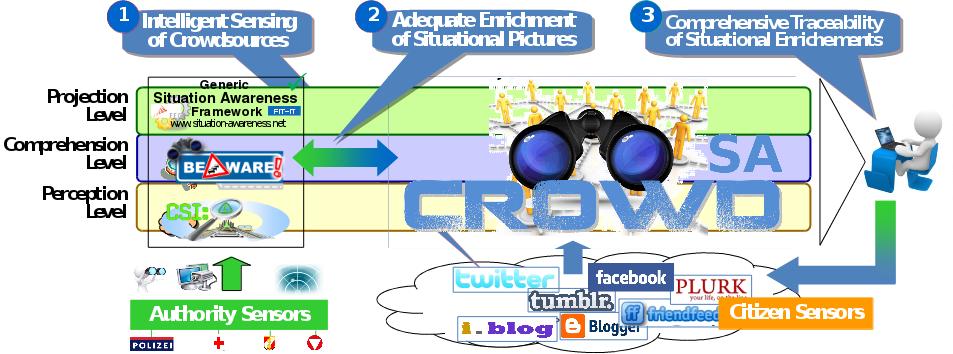About CrowdSA - Goals
Figure: Conceptual Architecture and Key Research Goals of crowdSA

Key Research Goal 1:
Intelligent Sensing of Crowdsources. The first key research goal of crowdSA – intelligent sensing of crowdsourced crisis information provided by diverse social media channels (notably Facebook and Twitter at a first stage) – leads to the following main challenges.
Sensor Adapters & Tuning. First, adapters are required to realize access to social media channels and to cope with heterogeneity of resulting formats. At the same time, tuning mechanisms are necessary, for adjusting the sensing1 of crisis information, supporting the determination of information need (i.e., search terms or concrete questions) as well as checks for relevancy of retrieved results.
Knowledge-based Extraction. Second, the unstructured content (retrieved besides structured metadata) has to be transformed into a structured format, going beyond conventional text processing. Also, crisis ontologies have to be established in order to give “meaning” to the information parts extracted, resulting together with the metadata in so-called crisis objects.
Key Research Goal 2:
Adequate Enrichment of Situational Pictures. The second goal targets the adequate enrichment of situational pictures with crisis objects and poses the following challenges.
Quality Analysis of Crisis Objects. First, quality analysis is one cornerstone for the acceptance of crowdsourcing in crisis management [Meie11], covering both, validity (aka. accuracy), i.e., the potential truth of observations and orthogonally, reliability (aka. precision), i.e., the degree of consistency between observations over time.
Fusion & Injection of Crisis Objects. Second, the steady stream of information from different channels and users, covering different (complementing, overlapping, or contradictory) perspectives, locations, and evolution stages has to be fused appropriately and injected into the existing situational picture either by extending already assessed critical situations or by instantiating new ones.
Key Research Goal 3:
Comprehensive Traceability of Situational Enrichments. The last goal deals with comprehensive traceability of situational enrichments, being the second crucial cornerstone for acceptance of crowdsourcing and thus raising the following challenges.
Provenance Representation & Visualization. First, authorities and citizens should be empowered to scrutinize each part of a situational picture by tracking back its origin all the way down to the social media channel it stems from, requiring proper representation and visualization of this provenance information.
Oblivious Provenance Generation. Second, for gathering provenance information covering all processing steps across the three levels of situation awareness while leaving them untouched, oblivious provenance generation techniques should be provided.
